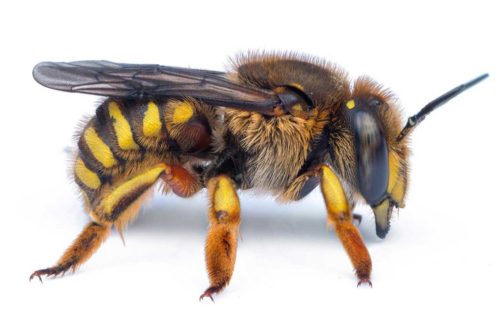
Any observant person with a garden knows that where there are flowers, there will also be bees. But bees are in trouble, and we can adapt our gardens to encourage and nurture them — perhaps including some of the native bees that can be found in Oregon.
The Oregon Bee Atlas recently added 224 unique bee species to its list, increasing the number of known native bees in Oregon to 650! It will take time to determine all their board and lodging needs, so let’s look out for the bees that visit our own gardens, and perhaps encourage more.
Bees vary widely in appearance. Some look like flies. Some look like wasps, to which they are closely related. But bees tend to be fuzzy, especially on the legs and thorax, while wasps are generally hairless and have more obvious “waists.”
Some bees are tiny. The smallest bees that I personally can identify as bees are about two-tenths of an inch long. Some bees are hairier than others, too, and they come in a variety of colors. Some are a gorgeous metallic green
Broad rules for encouraging bees? First, avoid using insecticides, herbicides and fungicides, all of which can and do harm bees. Provide food and housing. According to Oregon Bee Atlas taxonomist Lincoln Best, most bees either live in small groups or by themselves. Bees other than honey bees nest in small cavities in bare ground, plant stems, cracks and hollows in walls, trees (dead or alive) and clumpy vegetation like native bunch grasses.
You can help bees by limiting cleanup in some parts of your garden, stacking plant debris in piles and avoiding use of heavy or woody mulches on every scrap of bare ground. Some bees construct nests using mud and plant sap, and need access to mud or shallow water sources.
Gardeners with lots of space can help out by planting hedgerows of mixed native shrubs: native crab apple, chokecherry, osoberry, currant, Oregon grape, Nootka rose, ninebark and viburnum. Such a hedge as it matures will provide great cover for birds as well as food for bees — and multiple opportunities for bees to nest.
Some native bees may visit just one kind of flower their whole lives, but other bees are generalists: they eat nectar and pollen and are not that fussy about where they find them. But since bees come in many sizes and in different seasons, their needs are not all the same, so it’s important to provide a variety of flowers, native and non-native, for as long a season as possible.
Here in the Willamette Valley we can have flowers virtually year-round. If you grow snowdrops or hellebores, you most likely know that honey bees can appear on any sunny winter day. This January I noticed a tiny, jet-black bee, hardly bigger than a medium ant, resting on a snowdrop. Over-wintering bumble bee queens emerge from their nests quite early, with or without sunshine, and will even forage in the rain.
A bee garden should include composite flower types (daisies, sunflowers, native balsamroot, tar weed and aster), tubular flowers and flowers that are born in umbels (parsley, chervil, fennel and dill). Cup-shaped flowers such as crocus, California poppy and native clarkia are great for bumblebees. A herb garden is likely to attract plenty of bees, and lavender is another bumblebee favorite.
In the veggie garden, I let corn salad, cilantro and parsley plants go to seed, as well as arugula and, occasionally, bigger brassicas like broccoli and kale. I deliberately plant a few non-veggie things nearby that I know attract bees, such as catmint (a huge bee magnet) and cerinthe, an attractive early-blooming annual.
Limited space? Watch your own garden and those of neighbors in every season, and observe what bees seem to like. Research suggests that bees are attracted to spots where there are several species, so try to have at least three or four in bloom at any given time. Avoid “double” flowers — extra petals develop at the expense of nectaries.
Early flowers include hellebore, dandelion, crocus and snowdrop, candytuft, chickweed. Shrubs? Oregon grape, red-flowering currant, azara, blueberry and some viburnums. Mid-season sees many common garden annuals (borage, cosmos, zinnia) and garden perennials, including sages and clovers. Roses, too. Mid-to-late-season offers perennial salvias (sages), asters, anise hyssop, caryopteris (bluebeard) as well as many annuals and tender perennials.
Rachel Foster lives and gardens in Eugene. She can be reached at rfoster@efn.org.